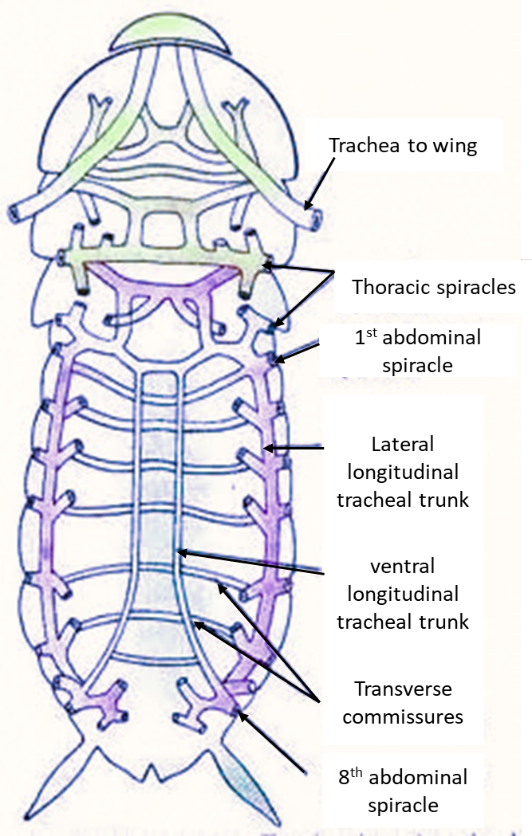Answer
413.4k+ views
Hint: They are the hexapod invertebrates and are the largest group within the arthropod phylum. They accomplished the respiration using a system of internal tubes and sacs.
Insects has a tracheal respiratory system in which the exchange of gases takes place at the tracheoles by the diffusion process. In this system, the tracheal carries oxygen directly to the body cells and does not require blood to transport it. In most of the insects, air is inhaled through openings on the sides of the abdomen and thorax called spiracles.
Complete answer:
Respiratory organs of insects:
Trachea: The respiratory system of arthropods consists of a network of the trachea. The trachea is an air tube lined with epithelial cells.
Taenidia: The cuticular lining of the trachea is spirally thickened that appears like ridges and form taenidia. It prevents the tracheal tubes from collapsing.
Spiracles: Trachea opens externally through ten pairs of small holes named spiracles present on the lateral side of the body. The opening of spiracles is regulated by sphincters.
Tracheoles: The tracheae further subdivided into finer branches called tracheoles which are air capillaries without inner taenidial ridges. Tracheoles are lined by a protein known as trachein and they are generally filled with a fluid in which oxygen dissolves and circulates to the tissues.
Tergo-sternal muscles: These paired muscles connect the dorsal side of the body to the ventral side and are responsible for breathing. On contraction, they compress the abdominal cavity forcing air to move out. During relaxed conditions, these muscles bring the abdominal cavity back into its original shape.
So, the correct answer is ‘Tracheae and spiracle ‘.
Note:
1. Each tracheal tube grows as an invagination of the ectoderm during embryonic development.
2. Some aquatic insects like mayfly and dragonfly larvae utilize tracheal gills for respiration in water.

Figure: Structure of respiratory organs in insects
Insects has a tracheal respiratory system in which the exchange of gases takes place at the tracheoles by the diffusion process. In this system, the tracheal carries oxygen directly to the body cells and does not require blood to transport it. In most of the insects, air is inhaled through openings on the sides of the abdomen and thorax called spiracles.
Complete answer:
Respiratory organs of insects:
Trachea: The respiratory system of arthropods consists of a network of the trachea. The trachea is an air tube lined with epithelial cells.
Taenidia: The cuticular lining of the trachea is spirally thickened that appears like ridges and form taenidia. It prevents the tracheal tubes from collapsing.
Spiracles: Trachea opens externally through ten pairs of small holes named spiracles present on the lateral side of the body. The opening of spiracles is regulated by sphincters.
Tracheoles: The tracheae further subdivided into finer branches called tracheoles which are air capillaries without inner taenidial ridges. Tracheoles are lined by a protein known as trachein and they are generally filled with a fluid in which oxygen dissolves and circulates to the tissues.
Tergo-sternal muscles: These paired muscles connect the dorsal side of the body to the ventral side and are responsible for breathing. On contraction, they compress the abdominal cavity forcing air to move out. During relaxed conditions, these muscles bring the abdominal cavity back into its original shape.
So, the correct answer is ‘Tracheae and spiracle ‘.
Note:
1. Each tracheal tube grows as an invagination of the ectoderm during embryonic development.
2. Some aquatic insects like mayfly and dragonfly larvae utilize tracheal gills for respiration in water.

Figure: Structure of respiratory organs in insects
Recently Updated Pages
How do you arrange NH4 + BF3 H2O C2H2 in increasing class 11 chemistry CBSE

Is H mCT and q mCT the same thing If so which is more class 11 chemistry CBSE

What are the possible quantum number for the last outermost class 11 chemistry CBSE

Is C2 paramagnetic or diamagnetic class 11 chemistry CBSE

What happens when entropy reaches maximum class 11 chemistry JEE_Main

Calculate the volume occupied by 88 gram of CO2 at class 11 chemistry CBSE

Trending doubts
Difference Between Plant Cell and Animal Cell

Difference between Prokaryotic cell and Eukaryotic class 11 biology CBSE

Fill the blanks with the suitable prepositions 1 The class 9 english CBSE

Change the following sentences into negative and interrogative class 10 english CBSE

Give 10 examples for herbs , shrubs , climbers , creepers

Fill the blanks with proper collective nouns 1 A of class 10 english CBSE

Select the word that is correctly spelled a Twelveth class 10 english CBSE

How fast is 60 miles per hour in kilometres per ho class 10 maths CBSE

What organs are located on the left side of your body class 11 biology CBSE



